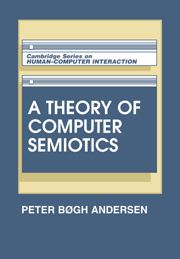Crossref Citations
This Book has been
cited by the following publications. This list is generated based on data provided by Crossref.
Schelhowe, Heidi
1997.
Frauenuniversitäten.
p.
137.
Desouza, Kevin C.
and
Hensgen, Tobin
2002.
On "Information" in Organizations: An Emergent Information Theory and Semiotic Framework.
Emergence,
Vol. 4,
Issue. 3,
p.
95.
Condon, Chris
Perry, Mark
and
O'Keefe, Robert
2004.
Denotation and connotation in the human – computer interface: The ‘Save as …’ command.
Behaviour & Information Technology,
Vol. 23,
Issue. 1,
p.
21.
Damjanovic, V.
Gasevic, D.
Devediiic, V.B.
and
Djuric, D.
2004.
The semiotics contribution on the Web.
p.
244.
Schelhowe, Heidi
2004.
Paradigms of Computing Science:.
Gender, Technology and Development,
Vol. 8,
Issue. 3,
p.
321.
Costabile, Maria Francesca
Fogli, Daniela
Mussio, Piero
and
Piccinno, Antonio
2007.
Visual Interactive Systems for End-User Development: A Model-Based Design Methodology.
IEEE Transactions on Systems, Man, and Cybernetics - Part A: Systems and Humans,
Vol. 37,
Issue. 6,
p.
1029.
Bolchini, Davide
Chatterji, Rupa
and
Speroni, Marco
2009.
Developing heuristics for the semiotics inspection of websites.
p.
67.
Moore, P.
Evans, C.
and
Tadros, G.
2013.
Towards Independent Assisted Living: The Application of Intelligent Context-Aware Systems.
p.
1180.
Moore, Philip
Evans, Cain
and
Pham, Hai V.
2013.
Web Information Systems Engineering – WISE 2011 and 2012 Workshops.
Vol. 7652,
Issue. ,
p.
27.
Moore, Philip
Xhafa, Fatos
and
Barolli, Leonard
2014.
Semantic Valence Modeling: Emotion Recognition and Affective States in Context-Aware Systems.
p.
536.
Rocchi, Paolo
2016.
What information to measure? How to measure it?.
Kybernetes,
Vol. 45,
Issue. 5,
p.
718.
Varalda, Wagner
and
Vega, Ítalo Santiago
2018.
Hermeneutical Elicitation of Requirements: A Technical Perspective to Improve the Conception of the Software Requirements.
Journal of Computer and Communications,
Vol. 06,
Issue. 09,
p.
132.
Dittrich, Yvonne
and
Piccinno, Antonio
2020.
Special issue on semiotics, human–computer interaction and end-user development.
Journal of Computer Languages,
Vol. 56,
Issue. ,
p.
100948.
Shackell, Cameron
and
Sitbon, Laurianne
2020.
Computational opposition analysis using word embeddings: A method for strategising resonant informal argument.
Argument & Computation,
Vol. 10,
Issue. 3,
p.
301.
Draude, Claude
2020.
Human-Computer Interaction. Design and User Experience.
Vol. 12181,
Issue. ,
p.
20.
Caccamo, Emmanuelle
and
Richert, Fabien
2022.
Les procédés algorithmiques au prisme des approches sémiotiques.
Cygne noir,
p.
1.
Ormerod, Richard John
2023.
The logic of semiotics applied to mathematical and social interaction in operational research consulting practice: Towards a foundational view.
Systems Research and Behavioral Science,
Vol. 40,
Issue. 1,
p.
16.
Topal, Ibrahim Halil
2024.
An edusemiotic approach to teaching intonation in the context of English language teacher education.
Semiotica,
Vol. 2024,
Issue. 259,
p.
185.



